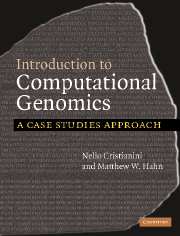Book contents
- Frontmatter
- Contents
- Preface
- Prologue: In praise of cells
- Chapter 1 The first look at a genome
- Chapter 2 All the sequence's men
- Chapter 3 All in the family
- Chapter 4 The boulevard of broken genes
- Chapter 5 Are Neanderthals among us?
- Chapter 6 Fighting HIV
- Chapter 7 SARS – a post-genomic epidemic
- Chapter 8 Welcome to the hotel Chlamydia
- Chapter 9 The genomics of wine-making
- Chapter 10 A bed-time story
- Bibliography
- Index
Prologue: In praise of cells
Published online by Cambridge University Press: 05 June 2012
- Frontmatter
- Contents
- Preface
- Prologue: In praise of cells
- Chapter 1 The first look at a genome
- Chapter 2 All the sequence's men
- Chapter 3 All in the family
- Chapter 4 The boulevard of broken genes
- Chapter 5 Are Neanderthals among us?
- Chapter 6 Fighting HIV
- Chapter 7 SARS – a post-genomic epidemic
- Chapter 8 Welcome to the hotel Chlamydia
- Chapter 9 The genomics of wine-making
- Chapter 10 A bed-time story
- Bibliography
- Index
Summary
The physicist Richard Feynman is credited with jump-starting the field of nanotechnology. In a talk at Caltech in December 1959, Feynman issued a famous challenge: he would pay $1000 to anyone who could write the entire Encyclopedia Britannica on the head of a pin. Feynman calculated that the size of the area was approximately 1/16 of an inch across (about 1.6 × 10−3 meters), and that in order to fit all 42 million letters of the Encyclopedia one would have to make each letter 1.0 × 10−8 meters across. It took (only) 26 years before the prize was finally claimed by a graduate student at Stanford University.
How cells work
What is a genome
The computational future of biology
A roadmap to this book
Now, consider the problem of having to write out the entire set of instructions needed to build and operate a human, and consider having to do so in each of the trillions of cells in the body. The entire human genome is 3.5 billion “letters” long, and each cell is only 2 microns (2 × 10−7 meters) across. (Actually, two complete copies of the genome are present in each cell, so we have to fit a bit more than 7 billion letters.) However all the organisms on earth overcome these packaging problems to live and prosper in a wide range of environments.
In the same 1959 lecture Feynman also imagined being able to look inside a cell in order to read all of the instructions and history contained within a genome.
- Type
- Chapter
- Information
- Introduction to Computational GenomicsA Case Studies Approach, pp. xi - xviiiPublisher: Cambridge University PressPrint publication year: 2006

